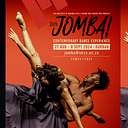Pather’s Immersive “surface tension” — a critical exploration of contemporary South Africa
By Samkelisiwe Nxumalo
As part of JOMBA! 2023 I got to experience the work of one of South Africa’s most revered contemporary choreographers; Jay Pather and his Siwela Sonke Dance Theatre. The presentation of “surface tension” at UKZN’s Jubilee Hall on 2 September was an unforgettable experience. Known for his site-responsive work, Pather’s “surface tension” certainly delivers by taking audiences out of the confines of the “black box” and into different locations. The performance deconstructs ideas around where performance can take place, and by taking it out of a theatre, Pather is able to create an immersive space that includes the audience as part of the performance.
The work begins in a garden that surrounds Jubilee Hall, dancers adopt different positions: atop a tree, in the bush and along the stair-case leading into the lower level of Jubilee Hall. The dancers, dressed in cammoflague, holding short LED light rods gave me a sense of a people readying for war. And as the work drew me in through its explorations of tensions I got the feeling of being part of a broader South African struggle — a country at war with itself and its own democracy.
As the dancers travel into the building, towards the audience, they sing “Asthathen’imkhonto, siyibambe, siyiphakamisele phezulu” (Let’s take spears, hold it upright). Pather’s subject matter is tension-driven and he is a choreographer who bravely and unapologetically explores a politics of being South African in the 21st Century. In his programme note, he refers to “surface tension” as “an interdisciplinary choreography that considers surface — layers of topographic maps, skin, hair, metal, cloth — as a prompt to re-find the body amidst the tensions that are wrought on its frame…”.
Through his use of cultural, traditional and contemporary icons, Pather creates a kind of controlled chaos that prompts audiences to ask important questions about under-spoken socio-political tensions that characterise contemporary South Africa. His use of such cultural references as the song, “My Mother was a kitchen girl, My father was a garden boy” acts as a reminder that, for many of South Africa’s Black youth, this remains true — despite the hope of a “born-free” generation. The work is unrelenting in its chaos and mess — literally and figuratively — as Pather forces us to take an honest look at our social tensions and the histories that inform these.
Choreographically, the work represents an intercultural exploration that exposes existing clashes between the past, the present and the past in the present. Powerfully, Pather explores how little of what is experienced by people comes to the surface, and how going on as “normal” starts to set up a toxic and complicated environment. This is seen as the dancers are met with various obstacles throughout the work — whether in terms of costuming and being asked to perform isiPantsula in a pair of flippers, or by having a gauze cloth layered and stretched over them and them moving under its surface… all of this adds to the intentional tension in the work.
Through the performance, I could feel the conflicts that we are faced with. Pather’s juxtaposition of African cultural belief systems alongside Christianity (embodied by so many who live in South Africa), and this offset by scenes where the dancers are vibing and partying, expose many layers and tensions within our collective South African psyche. The mirror on the stage gave me the idea of reflection, as an audience, we could see our lives in the performance as it accommodated all kinds of people.
The immersive experience and interdisciplinarity of the performance (across art forms as well as dance styles) has left me with a layered experience that will sit in my body and mind for some time still, as I continue to explore the different layers of meaning created through the work.
